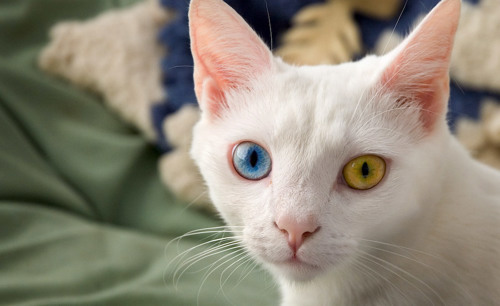
Why are white cats with blue eyes often deaf as well?
April 9, 2009

A high school teacher from Florida asks:
"Could you please explain the genetics behind white cats with blue eyes and the possible deafness because of this? I am looking for a simple explanation for my students. There is a lot of info out there, but in many, many places. It’s hard to find a simple explanation of all the alleles and genes involved without reading pages and pages about general cat breeding."
Your students have asked about a very complex subject! This condition, called Waardenburg syndrome or WS, is something that can happen in many animals, including cats and humans. We understand what is going on best in people, so that's where I'll focus.
Scientists have figured out that many different genes can cause WS. The main ones known to cause it are PAX3, MITF, TYR, RET, SOX10, EDN3, and EDNRB.
WS is passed on as a dominant trait. Which means that if one parent has WS, then you have at least a 50-50 shot of having it as well. The same goes for cats.
It turns out that not all WS patients have exactly the same symptoms. This is also true of cats with WS.
For example, only 40% of "odd-eyed" white cats with one blue eye are deaf. And only 65-85% of white cats with two blue eyes are deaf. The symptoms depend on which of the genes I listed above are not working right.
We don't have all the answers on exactly how changes in these genes cause WS. What we do know is that they all affect one thing -- how one type of cell moves during development.
How can just one type of cell cause lack of pigment in hair and eyes, and lead to deafness? It's because this one kind of cell can turn into many other kinds of cells. Let's look at how this happens and how these genes are involved to help understand how WS occurs.

Moving Cells
We all start out as a single fertilized egg. We then go on to develop into a 10 trillion-celled person with many different kinds of cells. This process is called development.
WS happens early in this process when a group of cells called the neural crest (NC) cells don't work properly. NC cells are a type of stem cell. They move to various parts of the body and become many other types of cells.
WS happens if the cells don't make it to the right place, or if they can't change into the right kind of cell once they get there. Think of the process like a cargo ship delivering its goods.
Imagine the cargo ship is delivering goods along the coast of California. The ship drops steel off in San Diego that is turned into navy ships, flour in Los Angeles that is turned into bread, and silicon in San Francisco that is turned into computer chips.
Cell migration works similarly. NC cells travel along the embryo. Some cells stay at the hair follicles and get turned into cells called melanocytes that give hair its color. Other cells stop at the eye and become melanocytes. And still other cells stop at the ear to become nerve fibers and other types of cells.
Now imagine that the ship drops off the wrong cargo. Or it sinks at sea. Now some places won't get what they need to build ships, bread, or chips.
How many places are affected depends on what happens to the ship. If they deliver fish instead of steel in San Diego, L.A. and San Francisco can still make bread and computer chips. But if the ship sinks before it gets to San Diego, then nothing gets made.
The same is true with WS. Some genes can affect the whole process causing deafness, white hair, and blue eyes. Other genes just affect part of the process. Now maybe you can hear but have a shock of white hair and blue eyes. Or just one blue eye.
Turning Genes On and Off
So how can these genes have their different effects? First, let's quickly review what genes are. Your genes are a collection of instructions for building you. Usually each gene has the instructions for one small part of you.
For example, there are genes for eye color. Or hair color. Or your specific taste buds. Pretty much everything about you is controlled by one or more genes.
In order for a gene to have an effect, it needs to be “read” by a cell. This is what is meant by a gene being turned on.
Not every cell needs to read every gene all the time. A cell in your foot does not need, for example, to be able to read a gene that lets you taste a certain chemical. So that gene is off in that cell.
The same is true during NC cell development. The right combination of genes must be turned on and off for an NC cell to become other types of cells. Genes must also be turned on or off to help that cell find where it is supposed to go.
NC cells (and all other cells) control which genes are on and off through, you guessed it, other genes. The genes involved in WS are these kinds of genes.

This all happens in layers kind of like on a ship. On our cargo ship, the captain runs everything. There are people who are in charge of steering the boat and unloading the cargo and many other jobs. And there are people who actually unload the boat and steer it.
If the captain fails to do his job, then none of our cargo gets delivered. If the guy in charge of deliveries makes a mistake, then the wrong supplies get delivered. And so on.
This is what happens in a cell too. There are master control genes like the captain that orchestrate most parts of NC migration. Then there are other genes that control only whether a cell differentiates into a melanocyte. Or others that control just the migration.
So the genes involved in WS have different effects because they control different sets of genes in NC cells. One nonworking gene might be like a confused helmsman. If the helmsman misses a port, then just bread or chips might be affected.
The same would be true for a "helmsman" gene. If it causes all of the NC cells to go to the wrong place, then you end up with a deaf cat with white hair and blue eyes. If the helmsman gene is just in charge of getting the cell to the hair and the left eye, then you'd end up with a white, "odd-eyed" cat that can hear.

Author: Jared Wenger
When this answer was published in 2009, Jared was a Ph.D. candidate in the Department of Genetics, studying yeast carbon metabolism and genome evolution in Gavin Sherlock’s laboratory. Jared wrote this answer while participating in the Stanford at The Tech program.
 Skip Navigation
Skip Navigation
